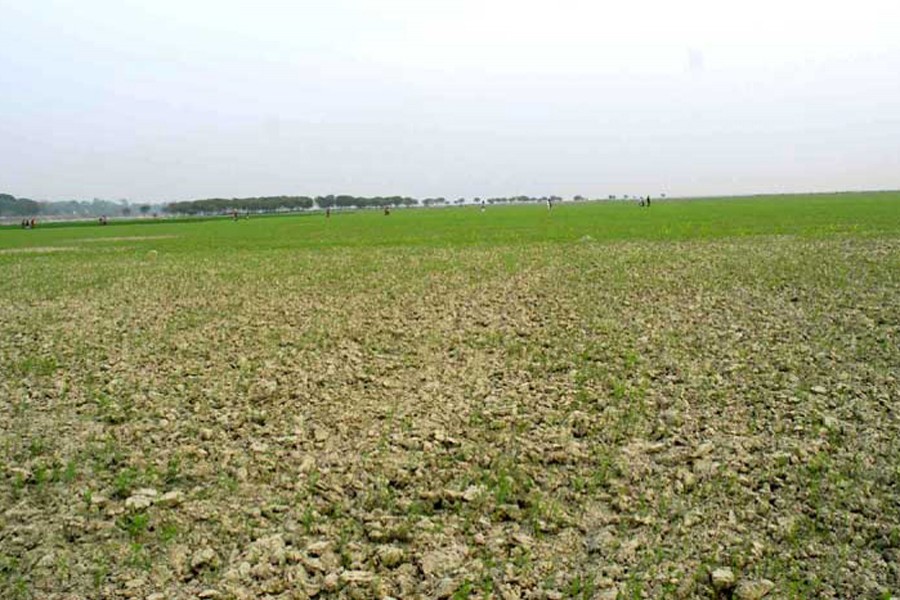
Depletion of flow turns Padma into emaciated stream in Rajshahi
Our Correspondent | Friday, 16 February 2018

RAJSHAHI, Feb 15: Due to depletion of flow of water, the mighty river Padma near Rajshahi has now turned to dried bed of sand dunes and silts. Every year, the river is losing its navigability with deposition of millions of tonnes of silt on the riverbed. The water in the river now visible for three to four months only and rests of eight to nine months of the year water level dropped to its lowest ebb resulting miles long sandy char land across the river. The mainstream Padma or the main flow of the river is from the right side of the river but the flow is now also turned to stagnant water bodies in the river bed.
The Padma near Rajshahi is now no way can be turned a 'mighty' river as this used to be called for thousands of years. It is now, rather, a dead river. The river flows beside the city of Rajshahi that is why the environment and livelihood of millions of people living along the river completely depends of the river Padma. For thousands of years, the river fed the city people and the people of the district with all her resources, often devouring its banks with its uncontrolled turbulent current and inundating a huge region beside it. Thousands of hectares of land have been devoured by this mighty river rendering thousands of people homeless, at the same time, creating in numerous tributaries and small rivers including the Mohananda, Pagla, Boral, Baranoi and Rayer Chand. All these tributaries are now full of deposit of sand and silt and in some places, it was hard to believe that some bone-dry spots were a part of river during recent past. Once big ships and boats used to cruise through the river but now paddy, pulses, mustard and other crops are grown on the riverbed.
According to the water sharing treaty with India, Bangladesh was to receive 27,000 cusecs of water through the outlets of Farakka during the dry season but Bangldesh never got her due share of water according to the water sharing deal.
According to Mahboob Siddiqui, Water and River Researcher, the river Padma is now a dead river. With drying up of the river, 25 more branch rivers originated from the river have also been dried up. Moreover, many more tributaries of Padma have been lost and have either turned to habitation or to cultivable land. Some of those lost rivers include: Chinar Kup (Damkura) river, Nabaganga, Sormongla (Raichand river) , Barahi and Chandana rivers. Of these, Sarmongla has turned to a No1 drain under the Rajshahi City Corporation. With the loss of these rivers and tributaries, tasty indigenous varieties of fishes have also been destroyed and soil of the surrounding areas of the rivers have lost its fertility. The surrounding environment of the rivers were becoming robust and unbearable day by day and valuable river resources are at stake rendering thousands of people unemployed.
Noted litterateur Professor Hasan Azizul Haque in this connection informed, rivers act like our mothers. Since Bangladesh is known as riverine country, the land of this country is fertile. Recurrent floodings of surrounding land beside the river have made our land fertile with a hub or greeneries. For these precious net of rivers, the nature and environment of the country is so unique. He further added, due to Farakka barrage, the flow of the mighty river Padma has been thwarted and the barrage was a great cause of huge mental torture for millions of people of our country.
However, to save Rajshahi city from the erosion of the river Padma, the Executive Committee of National Economic Council (ECNEC) has recently approved project worth Tk 2.86 billion through which 5.0 km long permanent river protection embankment will be constructed from Bulanpur of Rajpara police station to Sonaikandi under Paba upazila.
Water Development source in Rajshahi informed, from 2009 to 2015, nearly 1,200 kilometre long riverine route has been excavated in various rivers of the country including the river Padma. The source further apprehended, there will be no use of dredging and excavating at the dried river beds unless disposal of huge silts from upstream of the rivers is stopped.
bwjs123@gmail.com